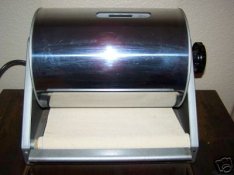Dear Jon,
You so have a drum dryer and it will dry and add glossy finish to your prints. I don't think it is a continuous type dryer, rather, you roll the drum/print/canvas until the print is completely held against the heated drum, wait until it is dry, then unroll it. You will know it is dry because it will pop off the drum on its own (don't try and remove it too soon, you will be sorry). Your unit will dry all fiber based paper but I would avoid using RC paper in it. If you decide to experiment with RC paper (again, I wouldn't), keep the temperature
very low (start with a low temp for fb too).
I dry all surfaces with the print face against the drum. Non-glossy surface paper must not be wet. If you can see liquid on the surface you will get a glossy spot even on matte papers. I let non glossy papers dry on a screen for a bit before putting them in the dryer. For glossy paper, any imperfection on the drum will be transferred to the print.
Keep the drum clean. Spots on the drum will show up on your prints.
Go here and search on Pakosol:
http://www.pakor.com/ This helps, but it won't substitute for carefully working towards the settings that work for you. Personally, I have not found it necessary but I would suggest using something like this
http://www.restorationproduct.com/renwaxinfo.html rather than car wax if getting the prints to release becomes a problem.
Start with a low temperature and unroll it every 5 min or so until the print comes off on its own. Work the temperature up slowly (waiting is easier than cleaning). It isn't the easiest darkroom technique to learn, but when done right you get the glossiest prints you have ever seen. Further, if you like matte prints, they will dry nice and flat using this device.
Good luck. I hope the experience isn't too frustrating. ;>)
Neal Wydra



